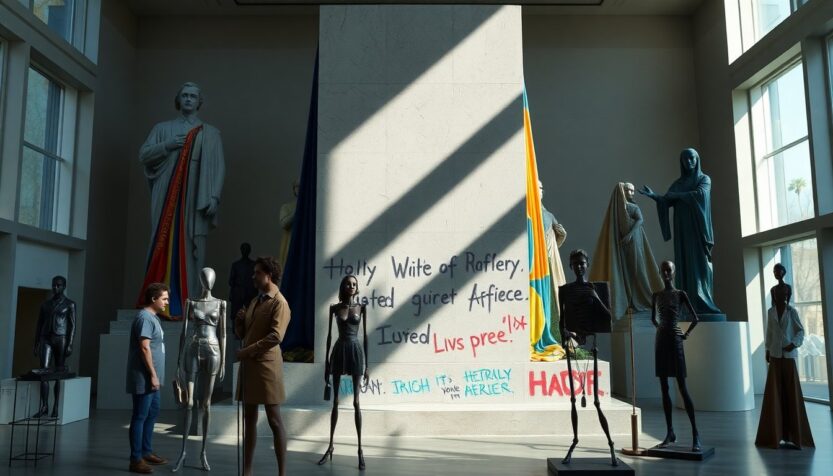In a significant artistic development, the Geffen Contemporary in Los Angeles has launched an exhibition titled Monuments. This exhibition explores the intricate relationship between decommissioned Confederate statues and contemporary art. It also includes works from the local nonprofit The Brick, aiming to spark dialogue about the narratives these monuments convey. By juxtaposing historical relics with modern interpretations, the exhibition encourages viewers to reconsider the symbolism associated with these once-celebrated structures.
Exploring the exhibition’s innovative perspective
The exhibition Monuments features Kara Walker’s notable sculpture Unmanned Drone, which is a reinterpretation of the statue of Confederate General Thomas J. “Stonewall” Jackson. Originally located in Charlottesville, Virginia, this statue symbolized the Lost Cause narrative until it was dismantled. Walker’s artistic reinterpretation of Jackson and his horse critiques the historical significance of such monuments. The work serves as a grotesque yet thought-provoking assembly that compels viewers to engage with and reassess their meanings.
Reimagining monuments
In her exhibition notes, artist Walker raises an important question: What should be done with these decommissioned monuments? She outlines two common reactions: either disregarding the painful histories they represent or eliminating them completely. Instead, Walker proposes a more innovative approach: to creatively reconstruct these symbols into new forms. This method not only acknowledges their histories but also transforms their narratives. Walker’s work resonates with audiences, prompting profound reflections on the past and its implications for the present.
Curatorial intentions and historical context
The exhibition Monuments is led by Hamza Walker, director of The Brick, alongside Bennett Simpson, senior curator at MOCA. Their collaboration has produced a compelling display that features fragments from various Confederate monuments. This exhibition invites viewers to reconsider the significance of these monuments in today’s society. A key highlight is a granite remnant from the former Robert E. Lee statue, which bears protest graffiti, symbolizing the ongoing fight against white supremacy.
Historical reflections
This exhibition is grounded in key historical events that have shaped recent discourse. Notably, the 2015 shooting at the Emanuel African Methodist Episcopal Church reignited discussions about Confederate symbols. The subsequent 2017 Unite the Right rally in Charlottesville further escalated the debate surrounding these monuments, prompting a series of removals in various cities. The curators of Monuments utilize this historical context to frame their exhibition, encouraging viewers to confront the significance of these statues in the contemporary cultural landscape.
Controversial reactions and ongoing debates
The exhibition has ignited intense discussions across various media platforms. Critics have expressed their views on social media, with some describing Walker’s work as grotesque, while others praise its boldness. This exhibition comes in the wake of the recent reinstatement of a Confederate statue in Washington, D.C., underscoring the persistent conflict between the preservation and erasure of historical narratives.
Hamza Walker highlights the intricate dynamics involved in the restoration of certain monuments. While some statues have been reinstated, others remain uncertain, igniting intense discussions regarding their future. A notable case is the Robert E. Lee statue, which was melted down following its removal. The bronze ingots that resulted from this process are now displayed in an exhibition. This transformation acts as a poignant metaphor for the evolving narratives surrounding Confederate monuments.
The role of art in societal change
Monuments serves as a vital platform for discussion regarding the impact of public art on our understanding of history. Contemporary artists are actively engaging with and reinterpreting Confederate statues, prompting viewers to confront the complex legacies of oppression and resilience that these structures represent. By addressing these difficult narratives, the exhibition not only seeks to reclaim historical agency but also fosters a more inclusive dialogue about the future of public monuments.

